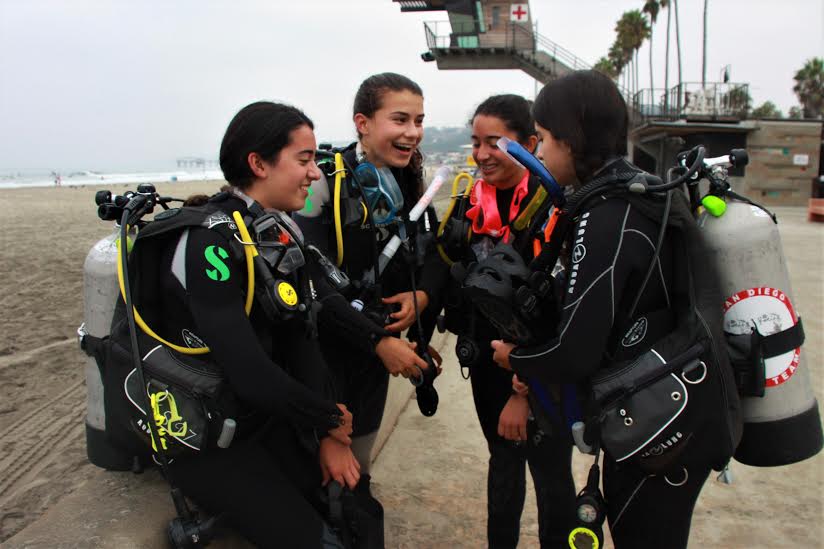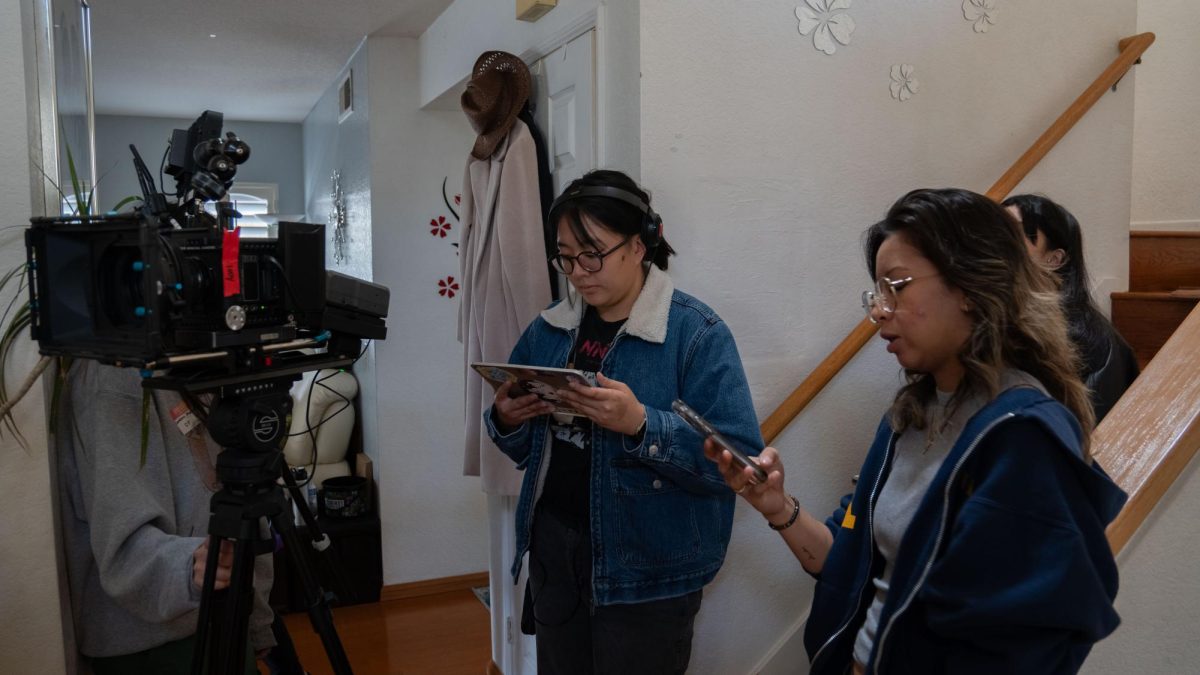 The waves of La Jolla Shores crashed against Renee Hopkins (11), Yasmin Yacoubian (11), and Sanam Yacoubian (11) as they lugged their 80-pound scuba diving gear into the ocean. Once they were 300 feet from the shore, on the count of three, the girls let their bodies sink, entering what seemed to be another world.
The waves of La Jolla Shores crashed against Renee Hopkins (11), Yasmin Yacoubian (11), and Sanam Yacoubian (11) as they lugged their 80-pound scuba diving gear into the ocean. Once they were 300 feet from the shore, on the count of three, the girls let their bodies sink, entering what seemed to be another world.
Beneath the surface, everything calmed, with only the sound of rhythmic breathing filling their ears.
At 10 feet underwater, stingrays sought cover under the sand. At 15, lobsters scurried along the ocean floor, and at 30, schools of fish jetted from one place to another.
“Everything is so alive down there,” Hopkins said. “There’s so much life, and it’s crazy when you’re 60 feet under and you look up to see this vast space of water above you. I thought I would feel so small in the huge ocean, but I actually felt really safe after going down and seeing that there is nothing dangerous.”
Similar to Hopkins, Yasmin initially held doubts about the ocean, but obtaining the scuba diving certification in August helped her overcome her fear.
“I was afraid of the ocean, which was part of the reason why I wanted to get certified,” Yasmin said. “I thought I was going to get hit by waves, but the moment you’re in your group with everyone around you and you’re just floating in the ocean, it’s so peaceful.”
The Yacoubian sisters come from a family of scuba divers, so after taking a trip to France’s beaches during summer, they became inspired to follow their dad’s footsteps in getting certified.
As for Hopkins, her interest sparked after a summer abroad in Spain, where her hostess sister had a passion for recreational scuba diving. Although Hopkins could not dive in Spain, she came home determined to get a license that allowed her to dive up to 60 feet underwater.
Hopkins immediately texted Sanam about her new aspiration, and by coincidence, the Yacoubians were signed up for a scuba diving class the following week at an instructor’s pool where they would learn how to assemble their gear and perform skills that they would do in the ocean.
After the girls passed an online course about the basic components required for scuba diving, and the 12 hours of pool-time with their instructors, they were ready to go into the ocean.
“Scuba diving is 90 percent work and 10 percent fun because you have to prepare so much, but that 10 percent is so worth it,” Yasmin said.
With an oxygen tank that lasts about an hour, about half of the air is used to get to the destination, only leaving about 10 to 20 minutes designated for exploring and sightseeing.
“You have so little time to take everything in, but I guess that’s what makes you appreciate it even more,” Hopkins said.
Despite being unable to talk to one another underwater, they believe their bonds have only grown stronger.
During their first dive in August, the girls
During their second dive a few days later, the girls went to La Jolla Shores once again, but this time it was at 6 a.m. in the rain, and Yasmin and Sanam’s older sister, Darya Yacoubian (’17), came along.
The currents underwater and the disheveled sand blurred their vision, causing Darya to drift away from the group.
In scuba diving, there’s a rule of thumb where if one of the divers gets lost from the group, they should all stay calm, spend up to two minutes searching, and then resurface. Without any reference points underwater, the three girls struggled to find Darya in those two minutes, as they couldn’t tell if they were going in a straight line or not.
“When Yasmin, Renee and I went up, we still couldn’t find my sister,” Sanam said. “At that point we hadn’t learned how to use our compasses yet. It took us 20 minutes to find her and the current pushed her out 100 feet.”
Sanam said that although scuba diving is incredible, there are many risks that they have to take into account before and during their dives.
To pass the certification test, the girls were required to perform a set of skills—one of which where they had to completely take off their masks 30 feet underwater and put it on again. For Hopkins, this was typically an easy task; however, in this particular dive, she struggled as bubbles from her breaths kept hitting her nose, causing her to choke.
“I wanted to breathe so bad but you can’t just swim up because that’s really dangerous and you just have to stay calm,” Hopkins said. “If you swim up you’ll get nitrogen bubbles in your lungs and you’re risking your health.”
In addition to the possibility that the gear could malfunction, the girls have to be cautious of their oxygen use as well as their body temperature because they are vulnerable to hypothermia. Simultaneously, they must equalize with the ocean’s atmospheric pressure while going lower into the ocean by popping their ears as the pressure increases. It is dangerous to neglect this step, as their eardrums would burst and potentially damage the brain.
“We were shivering down there, but if we tell our instructor that it’s too cold, we automatically fail,” Sanam said.
But despite these dangers, Sanam and her friends continue to scuba dive as it serves as an escape from our “human world.”
“You feel the weight of the gear pushing on you so it’s really physically painful above water,” Sanam said. “But because of pressure and buoyancy, below the water, it all goes away.”
Now licensed, the three hope to travel to Catalina Island in November, and in the future, become certified for cave diving.
“It’s really addictive in a way,” Hopkins said. “The world around you disappears, and your worries go away. The only thing you focus on is breathing and falling—nothing else.”
the air is used to get to the desired destination, only leaving about 10 to 20 minutes designated for exploring and sightseeing.
“You have so little time to take everything in, but I guess that’s what makes you appreciate it even more,” Hopkins said.
Despite being unable to talk to one another underwater, they believe their bonds have only grown stronger.
During their second dive a few days after their pool session, the girls went to La Jolla Shores once again, but this time it was at 6 a.m. in the rain, and Yasmin and Sanam’s older sister, Darya Yacoubian (’17), came along.
The currents underwater and the disheveled sand blurred their vision, causing Darya to drift away from the group.
In scuba diving, there’s a rule of thumb where if one of the divers gets lost from the group, they should all stay calm, spend up to two minutes searching, and then resurface. Without any reference points underwater, the three girls struggled to find Darya in those two minutes, as they couldn’t tell if they were going in a straight line or not.
“When Yasmin, Renee and I went up, we still couldn’t find my sister,” Sanam said. “At that point we hadn’t learned how to use our compasses yet. It took us 20 minutes to find her and the current pushed her out 100 feet.”
Sanam said that even though scuba diving is incredible, there are many risks that they have to take into account before and during their dives.
To pass the certification test, the girls were required to perform a set of skills—one of which where they had to completely take off their masks 30 feet underwater and put it on again. For Hopkins, this was typically an easy task; however, in this particular dive, she struggled as bubbles from her breaths kept hitting her nose, causing her to choke.
“I wanted to breathe so bad but you can’t just swim up because that’s really dangerous and you just have to stay calm,” Hopkins said. “If you swim up you’ll get nitrogen bubbles in your lungs and you’re risking your health.”
In addition to the possibility that the gear could malfunction, the girls have to be cautious of their oxygen use as well as their body temperature because they are vulnerable to hypothermia the longer and lower they go into the ocean. Simultaneously, they must equalize with the ocean’s atmospheric pressure while going lower into the ocean by popping their ears as the pressure increases. It is dangerous to neglect this step, as their eardrums would burst and potentially damage the brain.
“We were shivering so much down there, but if we told our instructor it was too cold, we would’ve automatically failed,” Sanam said.
But despite these dangers, Sanam and her friends continue to scuba dive as it serves as an escape from our “human world.”
“You feel the weight of the gear pushing on you so it’s physically painful above water,” Sanam said. “But because of pressure and buoyancy, below the water, it all goes away.”
During their initial dive, when the three reached 30 feet underwater and watched fish swim by, and nothing but the sound of their rhythmic breathing filled their ears, they stopped for a moment, immobilized by the beauty of the thousands of sand dollars that stretched across the ocean floor.
These sand dollars were different than the white, lifeless sand dollars they saw every so often at the beach in the past. These emanated a vibrant shade of purple.
“Sometimes I just want to tell Sanam and Yasmin that I saw something cool like a sand dollar or lobster, but there is obviously no specific hand gesture for that,” Hopkins said.
However, Hopkins found a better replacement for words or gestures—she swam to the ocean floor and used her finger to spell out in the sand “L-O-B-S-T-E-R.”
Now licensed, the three hope to travel to Catalina Island in November, and in the future, become certified for cave diving.
“It’s really addictive in a way,” Hopkins said. “The world around you disappears, and your worries go away. The only thing you focus on is breathing and falling—nothing else.”





